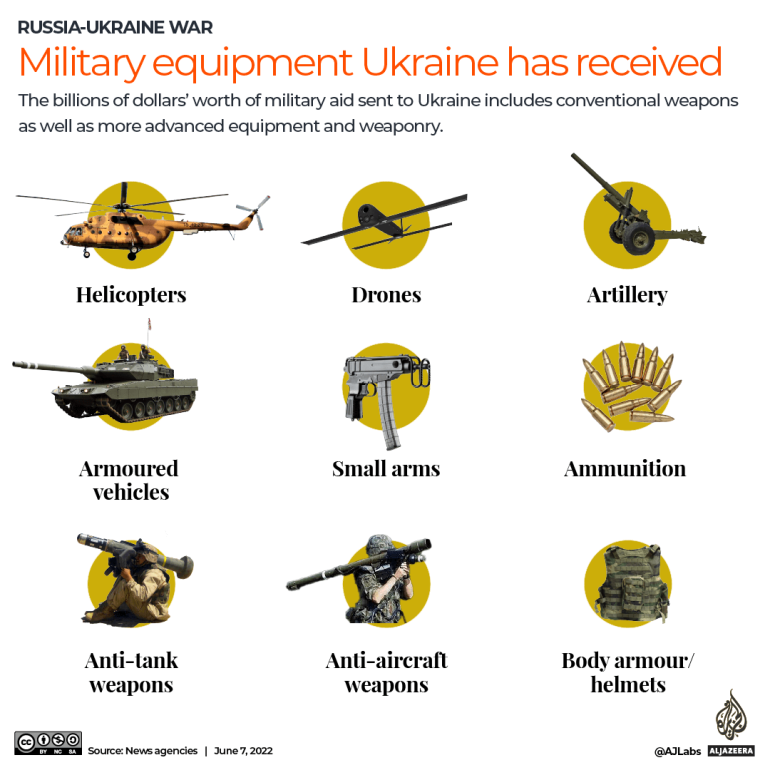
Cross-border raids from Ukraine into Russia were launched to draw away Moscow’s troops ahead of a planned counteroffensive by Kyiv, and to let Russians know the fight has now entered their territory, analysts say.
The two-day incursion took place far from the epicentre of fighting in Ukraine’s eastern Donbas region, and about 160km (100 miles) from the front lines in the northern Kharkiv region.
Though Kyiv has denied any role, the biggest cross-border raid from Ukraine since Russia invaded 15 months ago was almost certainly coordinated with Ukraine’s armed forces as it prepares to attempt to recapture territory, security experts said.
Patrick Bury, from the University of Bath, told Al Jazeera the border incursions in Russia’s western Belgorod region likely had three main objectives.
“Firstly it is to tie down as many Russian forces in the area as possible so they can’t man areas where Ukraine might actually attack. Secondly, it’s to show Russians across their media that the war has actually come to Russia on their territory in a small way. And, finally, to embarrass [Russian President Vladimir] Putin,” Bury said.
‘Open up gaps’
Ukraine says it plans to conduct a major counteroffensive to seize back occupied territory, but Russia has built sprawling fortifications in its neighbour’s east and south in readiness.
“The Ukrainians are trying to pull the Russians in different directions to open up gaps. The Russians are forced to send reinforcements,” said Neil Melvin, an analyst at the Royal United Services Institute.
“They’ll have to respond to this and put troops there and then have lots of troops all along the border area – even though that may not be the way the Ukrainians are coming.”
Russia’s military said on Tuesday it routed fighters who attacked Belgorod with armoured vehicles, killing more than 70 “Ukrainian nationalists” and pushing the remainder back into Ukraine.
Russians in the area expressed surprise at the severity of the attack. One woman was confirmed killed and nine civilians were wounded, some seriously, Belogrod’s Governor Vyacheslav Gladkov said.
“First guns, then mortars, and then machine guns. It was full-on fighting,” one unidentified resident told local media.
Gladkov said on Wednesday the territory was targeted by numerous drone strikes following the incursions.
“The night was not entirely calm. There were a large number of drone attacks. Air defence systems handled most of them,” Gladkov said on social media. “The most important thing is that there are no casualties.”
Kyiv has said the attack was carried out by Russian citizens, casting it as home-grown, internal Russian strife. Two groups operating in Ukraine – the Russian Volunteer Corps (RVC) and Freedom of Russia Legion – have claimed responsibility.
The groups were set up during Russia’s full-scale invasion and attracted Russian volunteer fighters wanting to fight against their own country alongside Ukraine and topple Putin.
‘Not independent forces’
Mark Galeotti, head of the London-based Mayak Intelligence consultancy and author of several books on the Russian military, said the two groups comprised anti-Kremlin Russians ranging from liberals and anarchists to neo-Nazis.
“They’re hoping that in some small way, they can contribute to the downfall of the Putin regime. But at the same time, we have to realise that these are not independent forces … They are controlled by Ukrainian military intelligence,” he said.
Ukrainian presidential aide Mykhailo Podolyak repeated Kyiv’s position that it had nothing to do with the operation.
Several similar incursions into Russia have occurred in recent months, and although this week’s was the largest known so far, it is still tiny when compared with front-line battles.
Win through ‘all means’ necessary
Kremlin spokesman Dmitry Peskov said on Wednesday that Russia will achieve all its goals in Ukraine either through its “special military operation” or through “all other means”, the state-run TASS news agency reported.
“Russia is taking under consideration only the completion of its special military operation: ensuring its interests, achieving Russia’s goals either through the special military operation or by other available means,” Peskov said.
Peskov earlier told reporters the attackers were Ukrainian.
“They are Ukrainian militants from Ukraine. There are many ethnic Russians living in Ukraine. But they are Ukrainian militants anyway,” he said.
Alexei Baranovsky, a spokesperson for the political wing of the Freedom of Russia Legion, told Reuters news agency in Kyiv he could not disclose the number of troops involved in the operation, but that the legion had four battalions in total.
Baranovsky denied there had been heavy losses, and he dismissed Russian reports of large casualties as disinformation.
He said the unit was part of Ukraine’s International Legion and, therefore, part of its armed forces, but denied the incursion was coordinated with Ukrainian authorities.
“These are the first steps in the main objective of overthrowing Putin’s regime through armed force. There are no other alternatives,” he said.
‘Rattle the Russians’
Galeotti said the incursion looked like a Ukrainian battlefield “shaping” operation ahead of Kyiv’s planned counteroffensive.
“This is really a chance to do two things: one is to rattle the Russians, make them worried about the possibility of risings amongst their own people. But secondly, force the Russians to disperse their troops,” he said.
Melvin noted the operation also served to boost morale in Ukraine.
Kyiv officials have mimicked the Kremlin’s rhetoric surrounding Russia’s annexation of Crimea in 2014 when it initially denied the troops involved were Russian.
Podolyak blamed the Belgorod incursion on “underground guerrilla groups” comprising Russian citizens.
On social media, Ukrainians referred to what they called the “Belgorod People’s Republic” – a nod to events in eastern Ukraine in 2014 when Russia-backed militias declared “people’s republics” in Ukraine’s Donetsk and Luhansk regions.
Ukrainians also circulated a video of President Volodymyr Zelenskyy delivering his famous “I am here” video address from Kyiv at the beginning of the invasion in February 2022. But instead of the presidential office in Kyiv, the background showed the welcome sign to the city of Belgorod.







